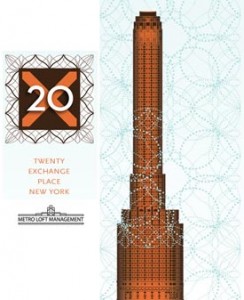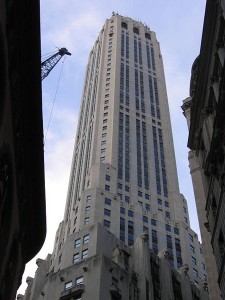Who’s Out to Buy the Collection?

20 Exchange Place – architectural rendering and logo
As of this writing, a week before the bidding ends, there’s only one confirmed offer for what’s variously referred to by the Minnesota Bankruptcy Court as the “Polaroid Fine Art Collection,” the “Artex Collection,” or the “Acquired Assets.” (These are all the 10,000 works in the U.S. currently stored in Somerville, MA.)
The Notice of Sale and Sale Procedures for the “Acquired Assets” and the “Sotheby’s Assets,” dated January 3, 2011, indicates that this bidder is the mysterious legal entity Perle Holdings, Inc., on whose ownership I speculated in my previous post. Whoever lies behind Perle Holdings, Inc., this corporation is unknown in the worlds of art, photography, and culture.
Now it appears that Perle Holdings, Inc. has acted on behalf of or in collaboration with yet another legal entity ― also unknown in the worlds of art, photography, and culture. Page 9 of the Motion for the Order of Sale (a public record filed with Doc. #1210 of the Bankruptcy Court) contains the following language:
“The Proposed Purchaser [Perle Holdings, Inc.] intends to acquire the Acquired Assets in order to allow this historical collection to largely remain intact, permit ongoing public display at a finished, museum quality space owned by an affiliate of the Proposed Purchaser located at 20 Exchange Place, New York, New York or through continued exhibitions at other institutions. The Proposed Purchaser intends to provide display and study opportunities with respect to the Acquired Assets for both general interest and scholarly audience [sic], as well as a continued resource in photography, motion pictures, technology and books.”
I have to assume that the “Proposed Purchaser” here deploys the term “museum quality” loosely. 20 Exchange Place is an 800,000-square-foot former office building in lower Manhattan, currently undergoing renovation by its latest owners, Metro Loft Management. They’re converting it into a mixed-use commercial/residential site. From the 20 Exchange Place website:

20 Exchange Place Tower
“20 Exchange Place was constructed in 1931 as the City Bank Farmers Trust Building. At that time the building was the 4th tallest building in the world and it remained among the top ten tallest buildings in New York until 1970. The building was designed by the architectural firm of Cross and Cross. In 1996, the building was designated a City Landmark by the New York City Landmarks Preservation Commission. Upon completion 20 Exchange Place will be converted into Downtown’s finest luxury rental apartments, making it one of Lower Manhattan’s tallest residential buildings to date.”
A September 10, 2009 puff piece by Amber V. Smith, masquerading as a news story at the website of the magazine Multifamily Executive and titled “A Tall Order,” explains that “20 Exchange Place now includes more than 500 studio, one-, and two-bedroom units located on the 16th to 57th floors; rents range from $2,100 to $6,000. The lower levels of the building feature office space and 130,000 square feet of retail space, ranging from boutiques to restaurants.”

Giants of Finance, 20 Exchange Place
Smith notes that “20 Exchange Place touts a modern art deco façade with 14 hooded ‘giants of finance’ figures outlining the exterior of the 19th floor; domed lobbies; and elegant arched ceilings detailed with gold, silver, and bronze. … In the lobby, the development team refurbished the columns made of 45 different kinds of marble and restored the ceiling, which is detailed with gold, bronze, and nickel. Outside, they restored the faded, crumbling limestone and brick façade to its original condition and polished the infamous 14 hooded statues — menacing, once again.” Given that the dismemberment of the Polaroid Collection resulted from the Ponzi scheme of Tom Petters, those “menacing giants of finance” will add a particularly apropos touch, methinks, if the fate of the Polaroid Collection comes to this.
Smith’s story continues, “To compete with other neighborhood rental buildings, Metro Loft chose to get creative with its amenities package. Out-of-the-box offerings include the free rental of cruiser bikes to use around Manhattan and a complimentary pet spa day on move-in day. Additionally, 20 Exchange Place provides residents with typical luxury amenities including a 24-hour doorman; concierge and valet services; fitness center; sundeck on the 19th floor; and a resident’s lounge with billiards and card tables, a wet bar, and flat screen televisions.” And now a “museum quality space … provid[ing] display and study opportunities with respect to the Acquired Assets for both general interest and scholarly audience, as well as a continued resource in photography, motion pictures, technology and books.”

Wenceslas Hollar, “A poodle, after Matham,” 1649
A marriage made in heaven (though better the Bellagio, if we’re going that route). Nothing a scholar likes better after a hard day in the archives than hanging in a Financial District wet bar with yuppies at happy hour, drinking boutique-vodka martinis while watching sports or MTV on the flat-screen. And the ability to park one’s poodle at the pet spa ― an option not normally available at a research center ― and to shop at the high-end mall in one’s off hours will surely make this a go-to resource for historians, curators, and other specialists from the international image community.
Call me skeptical, but in my opinion there’s simply no way that the owners of a chunk of pricey, newly rehabbed Wall Street real estate will set aside therein what any reputable arts institution would consider sufficient space for the storage, conservation, scholarly access, and rotating display of a unique and irreplaceable 10,000-piece collection, with appropriate temperature, humidity, and air-quality controls, safeguards against flooding, etc. ― not to mention the necessary crew of archivists, conservators, and such. By accepting this blatant flummery at face value, the Minnesota Bankruptcy Court demonstrates once again its cluelessness re the importance of this collection, and its utter disregard for issues of cultural heritage.

Yaron Bruckner
According to the document cited above, the party signing the bid and purchase agreement on behalf of Perle Holdings is one Nathan Bruckner. Smith’s report notes that “In 2004, the building was acquired as a joint venture by Metro Loft Management’s president Nathan Berman, Yaron Bruckner, and Eastbridge N.V. for $152 million.” Yaron Bruckner, born in Brussels in 1957, established the Brussels-based Eastbridge, and remains the company’s majority shareholder. The registration filed in Luxembourg for Eastbridge B.V. indicates that Nathan Bruckner, born in Monaco in 1986 ― along with several other younger Bruckners, all presumably relatives of Yaron ― also holds shares in Eastbridge. (I’ve extracted the pertinent sections in the PDF file linked to above. For the full document from the Luxembourg site, click here, then go to pages 32-24.)
So Nathan Bruckner, son of Yaron and minority shareholder in Eastbridge B.V., which owns 20 Exchange Place, is the agent for (or also a partner in) Perle Holdings, Inc., the prospective purchaser of the Polaroid Fine Art Collection. I find no indication anywhere that the Bruckners have any background that would fit them for oversight of an important archive of visual art.

20 Exchange Place logo
I’ll put my dollar on 20X turning the Polaroid Collection into trophy lobby decor, using it to accessorize its newly gentrified location, with perhaps a small dedicated gallery on the ground floor or in the retail area. That gallery will be rentable for social events, of course; nothing tones up a corporate cocktail party or an upscale wedding reception like world-class fine art on the walls, as museums around the country have discovered. And access to any part of the collection not on display will become so restricted that we might as well kiss it goodbye. (You read it here first.)
Happy to get proved wrong on any and all counts, as always. And glad to apologize to the Bruckners and the 20X team when they open a truly museum-quality space for the Polaroid Collection; hope springs eternal, yada yada. For the record, I’m not holding my breath. Just scratching my head. What perplexes me is what Perle Holdings, Eastbridge, 20X, the Bruckners, et al want with the 10,000-piece Polaroid Fine Art Collection, much of it useful primarily as study material, more suited to a museum, archive, or research center than to a small-scale Manhattan showcase.
 If you’re after a chunk of the original Polaroid Collection that’ll attract the public while adding some art glam to your upscale realty, why not go for the smaller, less expensive, easier to maintain “Sotheby’s Assets”? This is a group of perhaps 150 works still housed at Sotheby’s, including the ones not sold at the June auction, the ones withdrawn from the auction as a result of the campaign to stop the auction, and perhaps some others. Minimum price for these, the court indicates, would be $556.750.00 USD.
If you’re after a chunk of the original Polaroid Collection that’ll attract the public while adding some art glam to your upscale realty, why not go for the smaller, less expensive, easier to maintain “Sotheby’s Assets”? This is a group of perhaps 150 works still housed at Sotheby’s, including the ones not sold at the June auction, the ones withdrawn from the auction as a result of the campaign to stop the auction, and perhaps some others. Minimum price for these, the court indicates, would be $556.750.00 USD.
As I noted in my last post, since these represent items cherry-picked by Sotheby’s but not sold for one reason or another, they qualify de facto as what a prominent auction house considered auctionable, and thus constitute a knowledgeable culling of some of the best works from the collection. Auction-worthy = museum-worthy, and thus de facto private collection-worthy. Just right for the public and corporate spaces of 20X.
(To be continued.)
This post supported by a donation from journalist and researcher Melinda Pillsbury-Foster.
•
For an index of links to all previous posts related to this story, click here.
Polaroid Collection: Urgent Institutional Alert 2
Who’s Out to Buy the Collection?
20 Exchange Place – architectural rendering and logo
As of this writing, a week before the bidding ends, there’s only one confirmed offer for what’s variously referred to by the Minnesota Bankruptcy Court as the “Polaroid Fine Art Collection,” the “Artex Collection,” or the “Acquired Assets.” (These are all the 10,000 works in the U.S. currently stored in Somerville, MA.)
The Notice of Sale and Sale Procedures for the “Acquired Assets” and the “Sotheby’s Assets,” dated January 3, 2011, indicates that this bidder is the mysterious legal entity Perle Holdings, Inc., on whose ownership I speculated in my previous post. Whoever lies behind Perle Holdings, Inc., this corporation is unknown in the worlds of art, photography, and culture.
Now it appears that Perle Holdings, Inc. has acted on behalf of or in collaboration with yet another legal entity ― also unknown in the worlds of art, photography, and culture. Page 9 of the Motion for the Order of Sale (a public record filed with Doc. #1210 of the Bankruptcy Court) contains the following language:
“The Proposed Purchaser [Perle Holdings, Inc.] intends to acquire the Acquired Assets in order to allow this historical collection to largely remain intact, permit ongoing public display at a finished, museum quality space owned by an affiliate of the Proposed Purchaser located at 20 Exchange Place, New York, New York or through continued exhibitions at other institutions. The Proposed Purchaser intends to provide display and study opportunities with respect to the Acquired Assets for both general interest and scholarly audience [sic], as well as a continued resource in photography, motion pictures, technology and books.”
I have to assume that the “Proposed Purchaser” here deploys the term “museum quality” loosely. 20 Exchange Place is an 800,000-square-foot former office building in lower Manhattan, currently undergoing renovation by its latest owners, Metro Loft Management. They’re converting it into a mixed-use commercial/residential site. From the 20 Exchange Place website:
20 Exchange Place Tower
“20 Exchange Place was constructed in 1931 as the City Bank Farmers Trust Building. At that time the building was the 4th tallest building in the world and it remained among the top ten tallest buildings in New York until 1970. The building was designed by the architectural firm of Cross and Cross. In 1996, the building was designated a City Landmark by the New York City Landmarks Preservation Commission. Upon completion 20 Exchange Place will be converted into Downtown’s finest luxury rental apartments, making it one of Lower Manhattan’s tallest residential buildings to date.”
A September 10, 2009 puff piece by Amber V. Smith, masquerading as a news story at the website of the magazine Multifamily Executive and titled “A Tall Order,” explains that “20 Exchange Place now includes more than 500 studio, one-, and two-bedroom units located on the 16th to 57th floors; rents range from $2,100 to $6,000. The lower levels of the building feature office space and 130,000 square feet of retail space, ranging from boutiques to restaurants.”
Giants of Finance, 20 Exchange Place
Smith notes that “20 Exchange Place touts a modern art deco façade with 14 hooded ‘giants of finance’ figures outlining the exterior of the 19th floor; domed lobbies; and elegant arched ceilings detailed with gold, silver, and bronze. … In the lobby, the development team refurbished the columns made of 45 different kinds of marble and restored the ceiling, which is detailed with gold, bronze, and nickel. Outside, they restored the faded, crumbling limestone and brick façade to its original condition and polished the infamous 14 hooded statues — menacing, once again.” Given that the dismemberment of the Polaroid Collection resulted from the Ponzi scheme of Tom Petters, those “menacing giants of finance” will add a particularly apropos touch, methinks, if the fate of the Polaroid Collection comes to this.
Smith’s story continues, “To compete with other neighborhood rental buildings, Metro Loft chose to get creative with its amenities package. Out-of-the-box offerings include the free rental of cruiser bikes to use around Manhattan and a complimentary pet spa day on move-in day. Additionally, 20 Exchange Place provides residents with typical luxury amenities including a 24-hour doorman; concierge and valet services; fitness center; sundeck on the 19th floor; and a resident’s lounge with billiards and card tables, a wet bar, and flat screen televisions.” And now a “museum quality space … provid[ing] display and study opportunities with respect to the Acquired Assets for both general interest and scholarly audience, as well as a continued resource in photography, motion pictures, technology and books.”
Wenceslas Hollar, “A poodle, after Matham,” 1649
A marriage made in heaven (though better the Bellagio, if we’re going that route). Nothing a scholar likes better after a hard day in the archives than hanging in a Financial District wet bar with yuppies at happy hour, drinking boutique-vodka martinis while watching sports or MTV on the flat-screen. And the ability to park one’s poodle at the pet spa ― an option not normally available at a research center ― and to shop at the high-end mall in one’s off hours will surely make this a go-to resource for historians, curators, and other specialists from the international image community.
Call me skeptical, but in my opinion there’s simply no way that the owners of a chunk of pricey, newly rehabbed Wall Street real estate will set aside therein what any reputable arts institution would consider sufficient space for the storage, conservation, scholarly access, and rotating display of a unique and irreplaceable 10,000-piece collection, with appropriate temperature, humidity, and air-quality controls, safeguards against flooding, etc. ― not to mention the necessary crew of archivists, conservators, and such. By accepting this blatant flummery at face value, the Minnesota Bankruptcy Court demonstrates once again its cluelessness re the importance of this collection, and its utter disregard for issues of cultural heritage.
Yaron Bruckner
According to the document cited above, the party signing the bid and purchase agreement on behalf of Perle Holdings is one Nathan Bruckner. Smith’s report notes that “In 2004, the building was acquired as a joint venture by Metro Loft Management’s president Nathan Berman, Yaron Bruckner, and Eastbridge N.V. for $152 million.” Yaron Bruckner, born in Brussels in 1957, established the Brussels-based Eastbridge, and remains the company’s majority shareholder. The registration filed in Luxembourg for Eastbridge B.V. indicates that Nathan Bruckner, born in Monaco in 1986 ― along with several other younger Bruckners, all presumably relatives of Yaron ― also holds shares in Eastbridge. (I’ve extracted the pertinent sections in the PDF file linked to above. For the full document from the Luxembourg site, click here, then go to pages 32-24.)
So Nathan Bruckner, son of Yaron and minority shareholder in Eastbridge B.V., which owns 20 Exchange Place, is the agent for (or also a partner in) Perle Holdings, Inc., the prospective purchaser of the Polaroid Fine Art Collection. I find no indication anywhere that the Bruckners have any background that would fit them for oversight of an important archive of visual art.
20 Exchange Place logo
I’ll put my dollar on 20X turning the Polaroid Collection into trophy lobby decor, using it to accessorize its newly gentrified location, with perhaps a small dedicated gallery on the ground floor or in the retail area. That gallery will be rentable for social events, of course; nothing tones up a corporate cocktail party or an upscale wedding reception like world-class fine art on the walls, as museums around the country have discovered. And access to any part of the collection not on display will become so restricted that we might as well kiss it goodbye. (You read it here first.)
Happy to get proved wrong on any and all counts, as always. And glad to apologize to the Bruckners and the 20X team when they open a truly museum-quality space for the Polaroid Collection; hope springs eternal, yada yada. For the record, I’m not holding my breath. Just scratching my head. What perplexes me is what Perle Holdings, Eastbridge, 20X, the Bruckners, et al want with the 10,000-piece Polaroid Fine Art Collection, much of it useful primarily as study material, more suited to a museum, archive, or research center than to a small-scale Manhattan showcase.
As I noted in my last post, since these represent items cherry-picked by Sotheby’s but not sold for one reason or another, they qualify de facto as what a prominent auction house considered auctionable, and thus constitute a knowledgeable culling of some of the best works from the collection. Auction-worthy = museum-worthy, and thus de facto private collection-worthy. Just right for the public and corporate spaces of 20X.
(To be continued.)
This post supported by a donation from journalist and researcher Melinda Pillsbury-Foster.
•
For an index of links to all previous posts related to this story, click here.